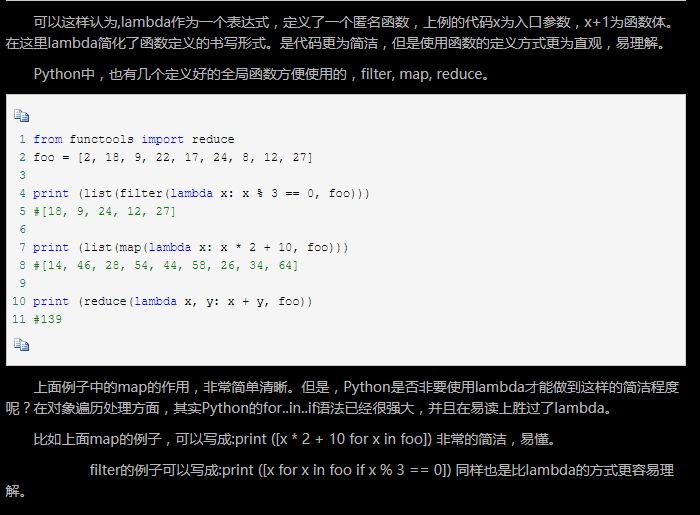python常用内置函数的作用
abs() #获取绝对值 chr() #返回数字对应的ASCII字符 cmp(x,y) #如果x<y 返回-1,x==y返回0 ,x> y返回1 compile() #函数将一个字符串编译为字节代码。 str = 'for i in [1,2,3,4,5,6,7] :print(i)' #name c = compile(str,'','exec') exec(str) exec() #函数将一句string类型的python代码执行 str = 'for i in [1,2,3,4,5,6,7] :print(i)' #name c = compile(str,'','exec') exec(str) eval() #函数将一个算数表达式执行 dict() #函数用来创建字典类型 zip() #函数可以将多个可迭代的对象按照相同的index转化为最短的tuple >>>a = [1,2,3] >>> b = [4,5,6] >>> c = [4,5,6,7,8] >>> zipped = zip(a,b) # 打包为元组的列表 [(1, 4), (2, 5), (3, 6)] >>> zip(a,c) # 元素个数与最短的列表一致 [(1, 4), (2, 5), (3, 6)] >>> zip(*zipped) # 与 zip 相反,可理解为解压,返回二维矩阵式 [(1, 2, 3), (4, 5, 6)] dir() #获取当前类型的方法 print(dir(list)) ['__add__', '__class__', '__contains__', '__delattr__', '__delitem__', '__dir__', '__doc__', '__eq__', '__format__', '__ge__', '__getattribute__', '__getitem__', '__gt__', '__hash__', '__iadd__', '__imul__', '__init__', '__init_subclass__', '__iter__', '__le__', '__len__', '__lt__', '__mul__', '__ne__', '__new__', '__reduce__', '__reduce_ex__', '__repr__', '__reversed__', '__rmul__', '__setattr__', '__setitem__', '__sizeof__', '__str__', '__subclasshook__', 'append', 'clear', 'copy', 'count', 'extend', 'index', 'insert', 'pop', 'remove', 'reverse', 'sort'] divmod() #函数把除数和余数运算结果结合起来,返回一个包含商和余数的元组(a // b, a % b)。 print(divmod(7,2)) (3, 1) enumerate() #把可遍历的对象组合成一个枚举对象,(索引,字段本身) >>>seasons = ['Spring', 'Summer', 'Fall', 'Winter'] >>> list(enumerate(seasons)) [(0, 'Spring'), (1, 'Summer'), (2, 'Fall'), (3, 'Winter')] >>> list(enumerate(seasons, start=1)) # 小标从 1 开始 [(1, 'Spring'), (2, 'Summer'), (3, 'Fall'), (4, 'Winter')] execfile() #函数可以用来执行一个文件。 format() #用{}和:代替以前的%
from functools import reduce
a = 1
b = 2
print(a+1 if a>b else b+1) #列表推导式 3
lis = [1,2,3,4,5]
print([i for i in lis if i%2 ==0]) #列表推导式 [2, 4]
a = list(map(lambda x :x**2 if x%3 == 0 else x,lis)) # map
print(a) #[1, 2, 9, 4, 5]
b = reduce(lambda x,y:x+y,lis) #reduce 15
print(b)
print(list(filter(lambda x:x%3 ==0,lis))) #filter [3]
print(sorted(lis,reverse=True)) #sorted [5, 4, 3, 2, 1]


